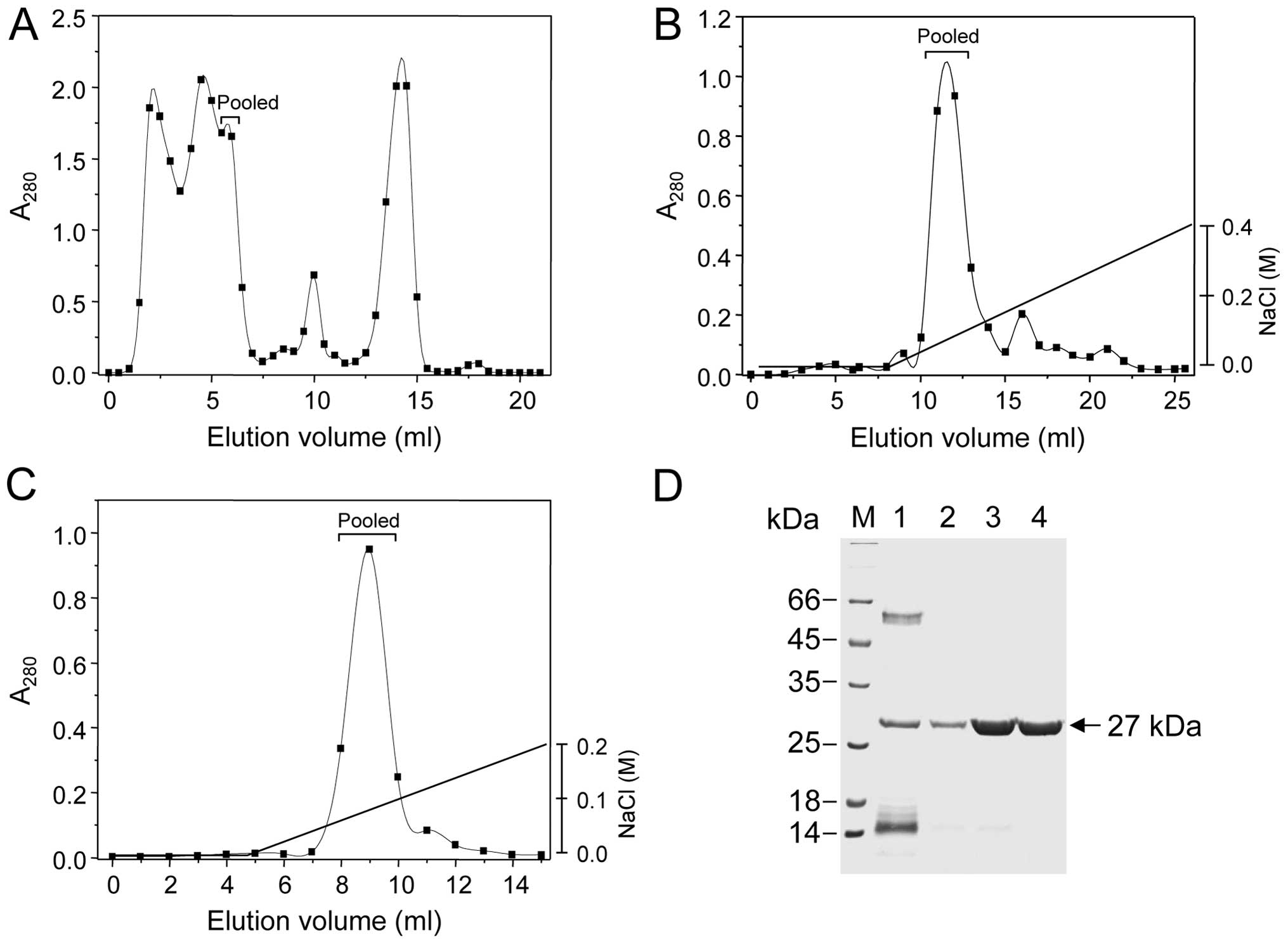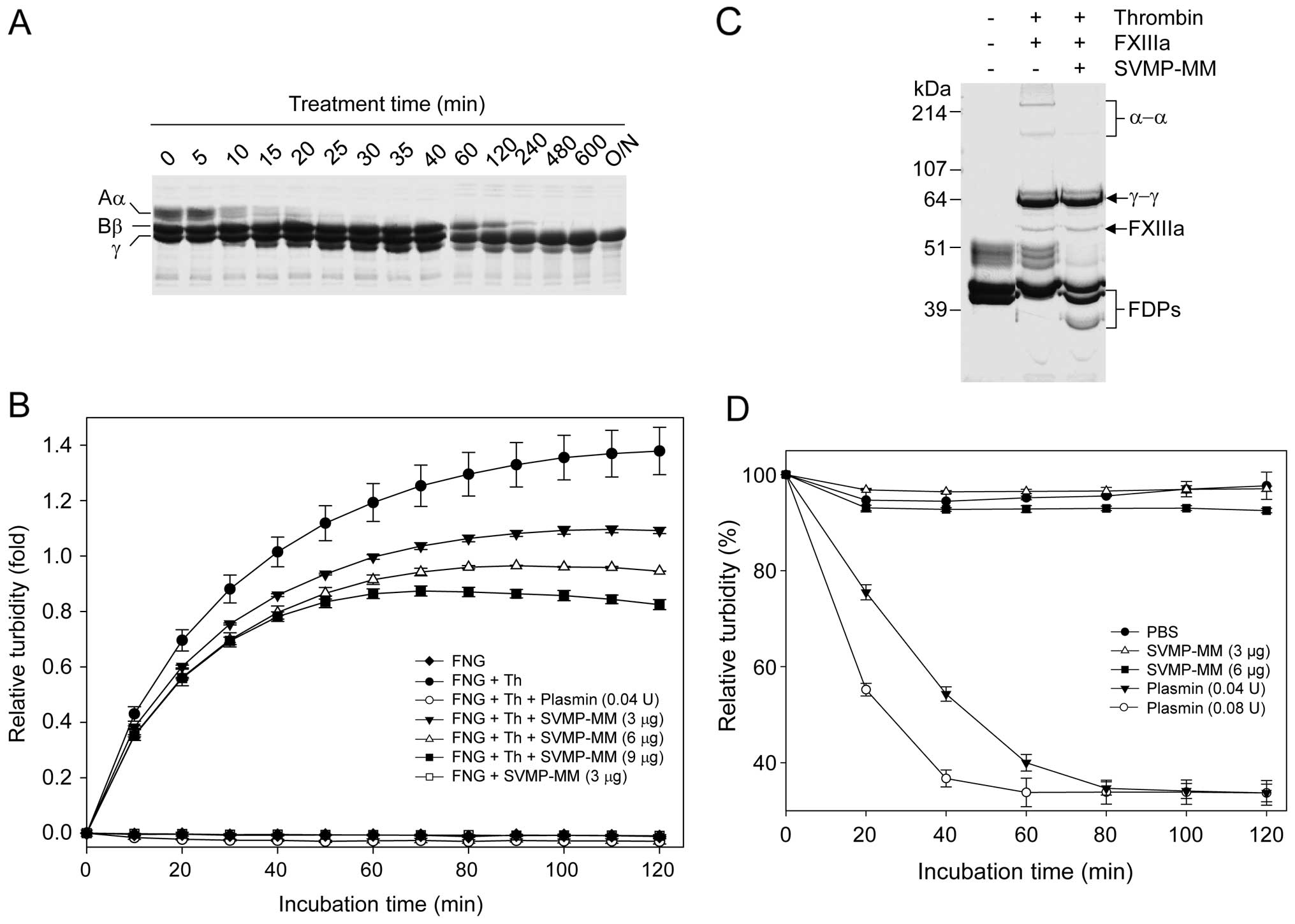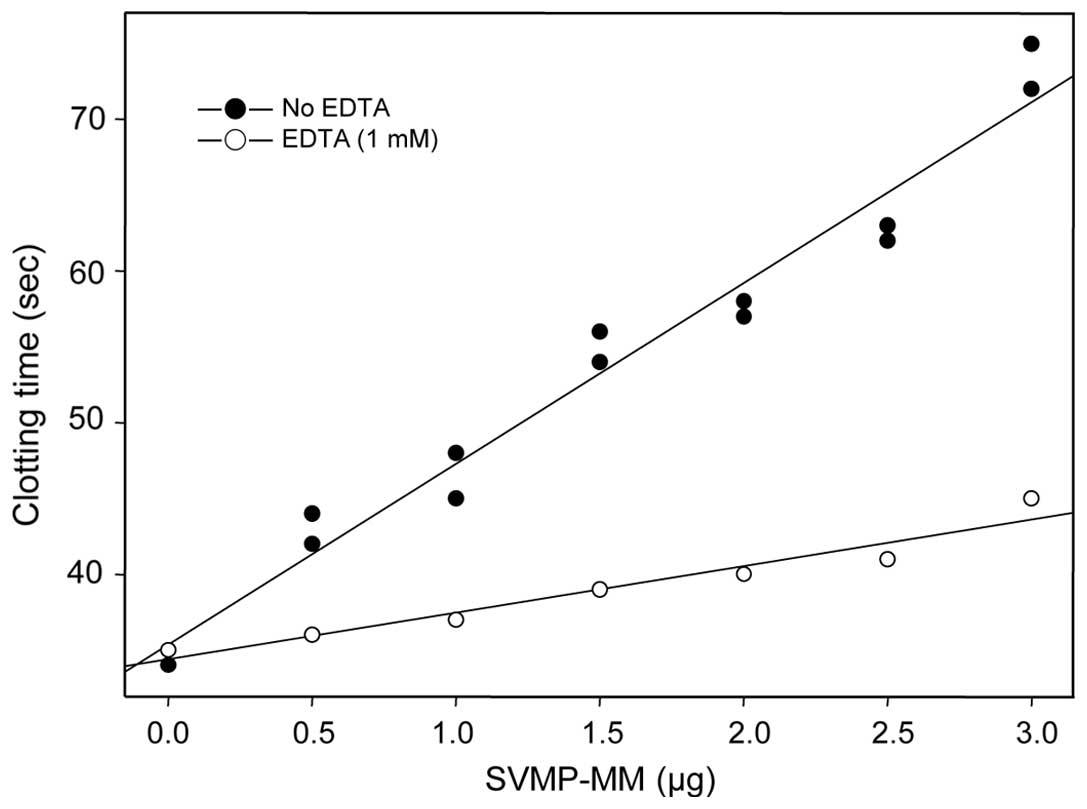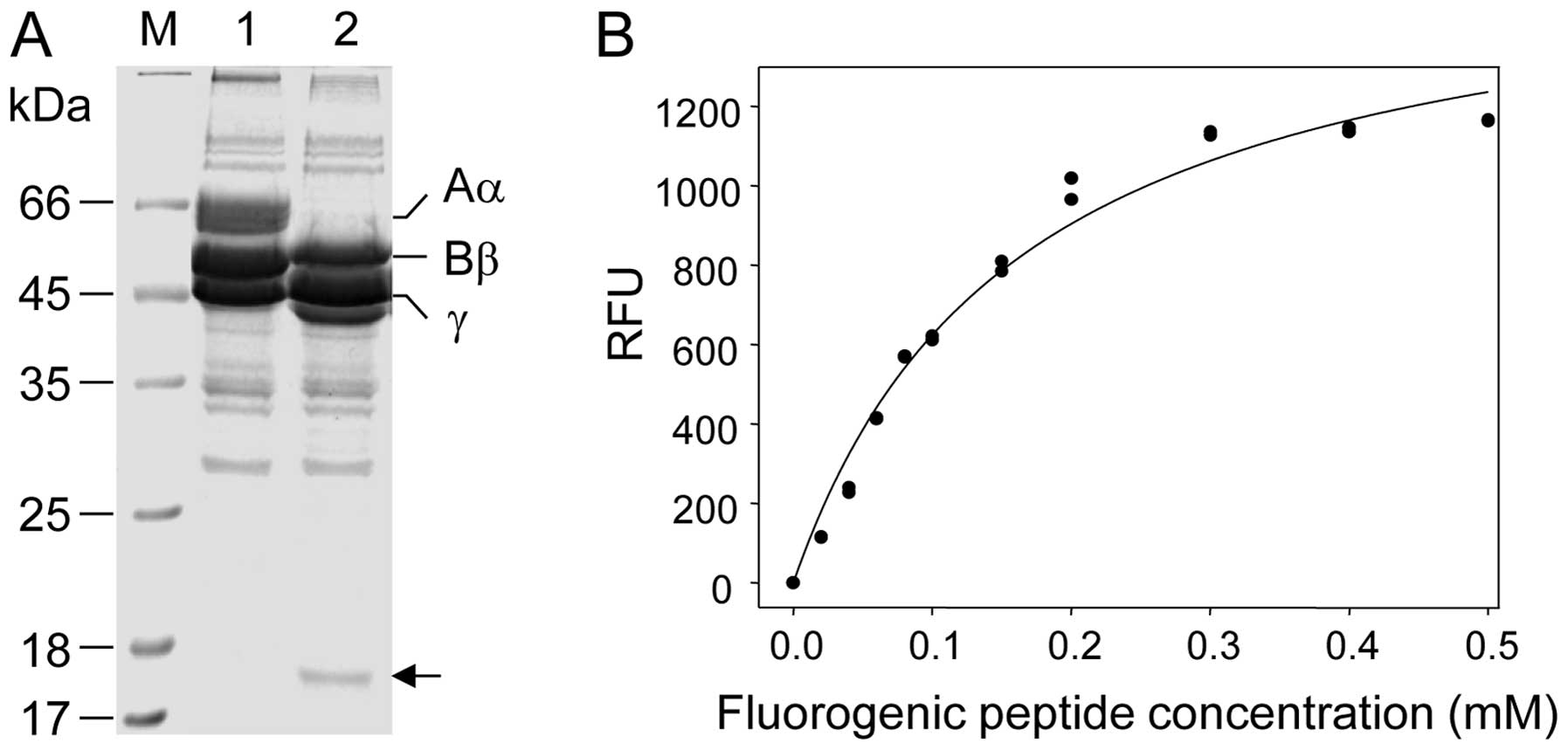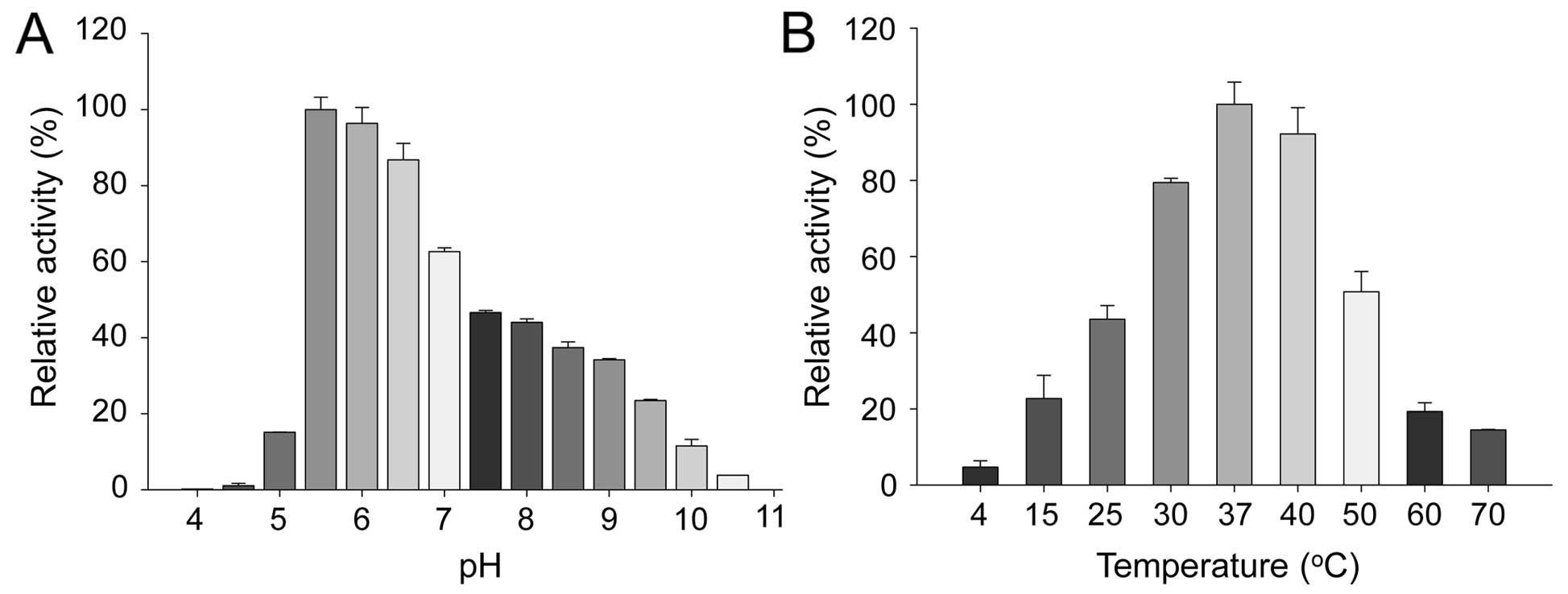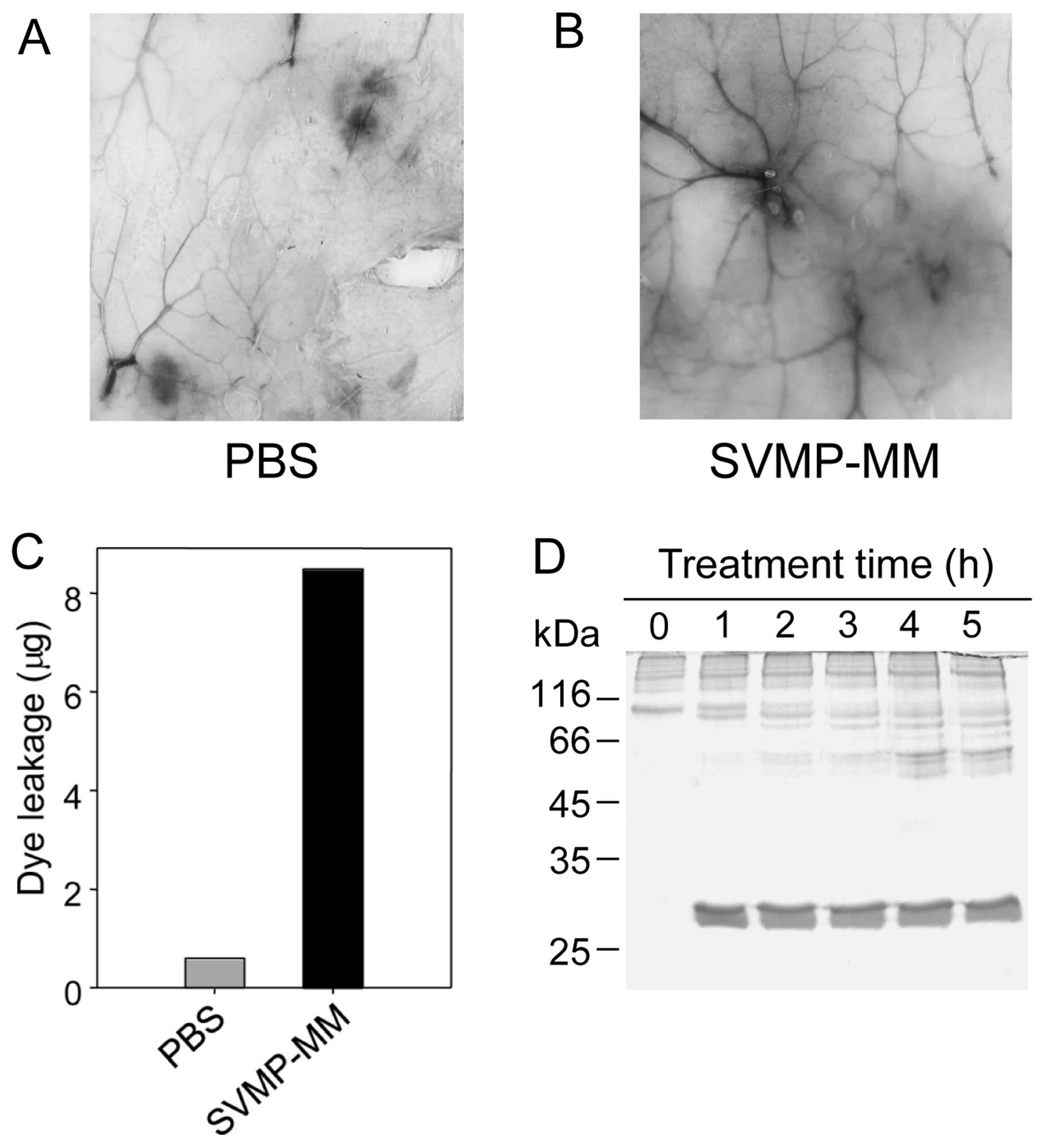|
1
|
Gutiérrez JM, Escalante T and Rucavado A:
Experimental pathophysiology of systemic alterations induced by
Bothrops asper snake venom. Toxicon. 54:976–987. 2009.
|
|
2
|
Rucavado A, Soto M, Escalante T, Loria GD,
Arni R and Gutiérrez JM: Thrombocytopenia and platelet
hypoaggregation induced by Bothrops asper snake venom.
Toxins involved and their contribution to metalloproteinase-induced
pulmonary hemorrhage. Thromb Haemost. 94:123–131. 2005.PubMed/NCBI
|
|
3
|
Takeda S, Takeya H and Iwanaga S: Snake
venom metalloproteinases: Structure, function and relevance to the
mammalian ADAM/ADAMTS family proteins. Biochim Biophys Acta.
1824:164–176. 2012. View Article : Google Scholar : PubMed/NCBI
|
|
4
|
White J: Snake venoms and coagulopathy.
Toxicon. 45:951–967. 2005. View Article : Google Scholar : PubMed/NCBI
|
|
5
|
Matsui T, Fujimura Y and Titani K: Snake
venom proteases affecting hemostasis and thrombosis. Biochim
Biophys Acta. 1477:146–156. 2000. View Article : Google Scholar : PubMed/NCBI
|
|
6
|
Markland FS Jr and Swenson S: Snake venom
metalloproteinases. Toxicon. 62:3–18. 2013. View Article : Google Scholar
|
|
7
|
Anderson SG and Ownby CL: Systemic
hemorrhage induced by proteinase H from Crotalus adamanteus
(eastern diamondback rattlesnake) venom. Toxicon. 35:1301–1313.
1997. View Article : Google Scholar : PubMed/NCBI
|
|
8
|
Nagy JA, Benjamin L, Zeng H, Dvorak AM and
Dvorak HF: Vascular permeability, vascular hyperpermeability and
angiogenesis. Angiogenesis. 11:109–119. 2008. View Article : Google Scholar : PubMed/NCBI
|
|
9
|
Tu AT, Baker B, Wongvibulsin S and Willis
T: Biochemical characterization of atroxase and nucleotide sequence
encoding the fibrinolytic enzyme. Toxicon. 34:1295–1300. 1996.
View Article : Google Scholar : PubMed/NCBI
|
|
10
|
Berger M, Pinto AF and Guimarães JA:
Purification and functional characterization of bothrojaractivase,
a prothrombin-activating metalloproteinase isolated from
Bothrops jararaca snake venom. Toxicon. 51:488–501. 2008.
View Article : Google Scholar
|
|
11
|
Kress LF and Catanese J: Enzymatic
inactivation of human antithrombin III. Limited proteolysis of the
inhibitor by snake venom proteinases in the presence of heparin.
Biochim Biophys Acta. 615:178–186. 1980. View Article : Google Scholar
|
|
12
|
Garrigues T, Dauga C, Ferquel E, Choumet V
and Failloux A-B: Molecular phylogeny of Vipera Laurenti,
1768 and the related genera Macrovipera (Reuss, 1927) and
Daboia (Gray, 1842), with comments about neurotoxic
Vipera aspis aspis populations. Mol Phylogenet Evol.
35:35–47. 2005.
|
|
13
|
Lago NR, de Adolfo Roodt R, Archundia I,
et al: Local damage produced by Vipera and
Macrovipera venoms and some immunochemical characteristics.
Toxicon. 60:2272012.
|
|
14
|
Archundia IG, de Roodt AR, Ramos-Cerrillo
B, et al: Neutralization of Vipera and Macrovipera
venoms by two experimental polyvalent antisera: A study of
paraspecificity. Toxicon. 57:1049–1056. 2011.PubMed/NCBI
|
|
15
|
Samel M, Subbi J, Siigur J and Siigur E:
Biochemical characterization of fibrinogenolytic serine proteinases
from Vipera lebetina snake venom. Toxicon. 40:51–54. 2002.
View Article : Google Scholar : PubMed/NCBI
|
|
16
|
Siigur J, Samel M, Tõnismägi K, Subbi J,
Siigur E and Tu AT: Biochemical characterization of lebetase, a
direct-acting fibrinolytic enzyme from Vipera lebetina snake
venom. Thromb Res. 90:39–49. 1998. View Article : Google Scholar : PubMed/NCBI
|
|
17
|
Trummal K, Vija H, Subbi J and Siigur J:
MALDI-TOF mass spectrometry analysis of substrate specificity of
lebetase, a direct-acting fibrinolytic metalloproteinase from
Vipera lebetina snake venom. Biochim Biophys Acta.
1476:331–336. 2000. View Article : Google Scholar
|
|
18
|
Swenson S and Markland FS Jr: Snake venom
fibrin(ogen)olytic enzymes. Toxicon. 45:1021–1039. 2005. View Article : Google Scholar : PubMed/NCBI
|
|
19
|
Leonardi A, Fox JW, Trampus-Bakija A and
Krizaj I: Ammodytase, a metalloprotease from Vipera
ammodytes venom, possesses strong fibrinolytic activity.
Toxicon. 49:833–842. 2007.
|
|
20
|
Markland FS Jr: Snake venom
fibrinogenolytic and fibrinolytic enzymes: an updated inventory.
Registry of Exogenous Hemostatic Factors of the Scientific and
Standardization Committee of the International Society on
Thrombosis and Haemostasis. Thromb Haemost. 79:668–674. 1998.
|
|
21
|
Buschek S, Ignjatovic V, Summerhayes R and
Lowe R: The effect of different snake venoms and anti-venoms on
thrombin clotting time in human plasma. Thromb Res. 125:e149–e152.
2010. View Article : Google Scholar : PubMed/NCBI
|
|
22
|
Park JW, Park JE, Choi HK, Jung TW, Yoon
SM and Lee JS: Purification and characterization of three
thermostable alkaline fibrinolytic serine proteases from the
polychaete Cirriformia tentaculata. Process Biochem.
48:979–987. 2013. View Article : Google Scholar
|
|
23
|
Laemmli UK: Cleavage of structural
proteins during the assembly of the head of bacteriophage
T4. Nature. 227:680–685. 1970. View Article : Google Scholar : PubMed/NCBI
|
|
24
|
Chang AK, Kim HY, Park JE, et al:
Vibrio vulnificus secretes a broad-specificity
metalloprotease capable of interfering with blood homeostasis
through prothrombin activation and fibrinolysis. J Bacteriol.
187:6909–6916. 2005. View Article : Google Scholar
|
|
25
|
Miles AA and Miles EM: Vascular reactions
to histamine, histamine-liberator and leukotaxine in the skin of
guinea-pigs. J Physiol. 118:228–257. 1952. View Article : Google Scholar : PubMed/NCBI
|
|
26
|
Stroka A, Donato JL, Bon C, Hyslop S and
de Araújo AL: Purification and characterization of a hemorrhagic
metalloproteinase from Bothrops lanceolatus (Fer-de-lance)
snake venom. Toxicon. 45:411–420. 2005. View Article : Google Scholar
|
|
27
|
Gasmi A, Srairi N, Karoui H and El Ayeb M:
Amino acid sequence of VlF: identification in the C-terminal domain
of residues common to non-hemorrhagic metalloproteinases from snake
venoms. Biochim Biophys Acta. 1481:209–212. 2000. View Article : Google Scholar : PubMed/NCBI
|
|
28
|
Watanabe L, Shannon JD, Valente RH, et al:
Amino acid sequence and crystal structure of BaP1, a
metalloproteinase from Bothrops asper snake venom that
exerts multiple tissue-damaging activities. Protein Sci.
12:2273–2281. 2003. View Article : Google Scholar : PubMed/NCBI
|
|
29
|
Okamoto DN, Kondo MY, Oliveira LC, et al:
P-I class metalloproteinase from Bothrops moojeni venom is a
post-proline cleaving peptidase with kininogenase activity:
Insights into substrate selectivity and kinetic behavior. Biochim
Biophys Acta. 1844:545–552. 2014.
|
|
30
|
Rodrigues VM, Soares AM, Guerra-Sá R,
Rogrigues V, Fontes MR and Giglio JR: Structural and functional
characterization of neuwiedase, a nonhemorrhagic
fibrin(ogen)olytic. Arch Biochem Biophys. 38:213–224. 2000.
View Article : Google Scholar : PubMed/NCBI
|
|
31
|
Siigur E, Aaspõllu A, Tu AT and Siigur J:
cDNA cloning and deduced amino acid sequence of fibrinolytic enzyme
(lebetase) from Vipera lebetina snake venom. Biochem Biophys
Res Commun. 224:229–236. 1996. View Article : Google Scholar : PubMed/NCBI
|
|
32
|
Sajevic T, Leonardi A, Kovačič L, et al:
VaH3, one of the principal hemorrhagins in Vipera ammodytes
ammodytes venom, is a homodimeric P-IIIc metalloproteinase.
Biochimie. 95:1158–1170. 2013.PubMed/NCBI
|
|
33
|
Huang KF, Hung CC, Pan FM, Chow LP,
Tsugita A and Chiou SH: Characterization of multiple
metalloproteinases with fibrinogenolytic activity from the venom of
Taiwan habu (Trimeresurus mucrosquamatus): protein
microsequencing coupled with cDNA sequence analysis. Biochem
Biophys Res Commun. 216:223–233. 1995. View Article : Google Scholar : PubMed/NCBI
|
|
34
|
Xiao R, Li QW, Perrett S and He RQ:
Characterisation of the fibrinogenolytic properties of the buccal
gland secretion from Lampetra japonica. Biochimie.
89:383–392. 2007. View Article : Google Scholar : PubMed/NCBI
|
|
35
|
Doolittle RF, Watt KWK, Cottrell BA,
Strong DD and Riley M: The amino acid sequence of the alpha-chain
of human fibrinogen. Nature. 280:464–468. 1979. View Article : Google Scholar : PubMed/NCBI
|
|
36
|
Araujo MC, Melo RL, Cesari MH, Juliano MA,
Juliano L and Carmona AK: Peptidase specificity characterization of
C- and N-terminal catalytic sites of angiotensin I-converting
enzyme. Biochemistry. 39:8519–8525. 2000. View Article : Google Scholar : PubMed/NCBI
|
|
37
|
Baker AH, Edwards DR and Murphy G:
Metalloproteinase inhibitors: biological actions and therapeutic
opportunities. J Cell Sci. 115:3719–3727. 2002. View Article : Google Scholar : PubMed/NCBI
|
|
38
|
Norris LA: Blood coagulation. Best Pract
Res Clin Obstet Gynaecol. 17:369–383. 2003. View Article : Google Scholar
|
|
39
|
Yamazaki Y, Nakano Y, Imamura T and Morita
T: Augmentation of vascular permeability of VEGF is enhanced by
KDR-binding proteins. Biochem Biophys Res Commun. 355:693–699.
2007. View Article : Google Scholar : PubMed/NCBI
|
|
40
|
Gasmi A, Srairi N, Guermazi S, Dekhil H,
Karoui H and El Ayeb M: Amino acid structure and characterization
of a heterodimeric disintegrin from Vipera lebetina venom.
Biochim Biophys Acta. 1547:51–56. 2001. View Article : Google Scholar : PubMed/NCBI
|
|
41
|
Pereira AL, Fritzen M, Faria F, Motta G
and Chudzinski-Tavassi AM: Releasing or expression modulating
mediator involved in hemostasis by Berythractivase and Jararhagin
(SVMPs). Toxicon. 47:788–796. 2006. View Article : Google Scholar : PubMed/NCBI
|
|
42
|
Randolph A, Chamberlain SH, Chu HL,
Retzios AD, Markland FS Jr and Masiarz FR: Amino acid sequence of
fibrolase, a direct-acting fibrinolytic enzyme from Agkistrodon
contortrix contortrix venom. Protein Sci. 1:590–600. 1992.
View Article : Google Scholar : PubMed/NCBI
|
|
43
|
Aaspõllu A, Siigur J and Siigur E: cDNA
cloning of a novel P-I lebetase isoform Le-4. Toxicon. 46:591–594.
2005.PubMed/NCBI
|
|
44
|
Oyama E, Kitagawa Y and Takahashi H:
Primary structure and characterization of a non hemorrhagic
metalloproteinase with fibrinolytic activity, from the snake venom
of Protobothrops tokarensis (Tokara-habu). Toxicon.
70:153–161. 2013. View Article : Google Scholar : PubMed/NCBI
|
|
45
|
Wahby AF, Mahdy el SM, El-Mezayen HA,
Salama WH, Abdel-Aty AM and Fahmy AS: Egyptian horned viper
Cerastes cerastes venom hyaluronidase: purification, partial
characterization and evidence for its action as a spreading factor.
Toxicon. 60:1380–1389. 2012.
|
|
46
|
Bernardes CP, Menaldo DL, Camacho E, et
al: Proteomic analysis of Bothrops pirajai snake venom and
characterization of BpirMP, a new P-I metalloproteinase. J
Proteomics. 80:250–267. 2013.
|
|
47
|
Bernardes CP, Santos-Filho NA, Costa TR,
et al: Isolation and structural characterization of a new
fibrin(ogen)olytic metalloproteinase from Bothrops moojeni
snake venom. Toxicon. 51:574–584. 2008. View Article : Google Scholar : PubMed/NCBI
|
|
48
|
Sun MZ, Liu S and Greenaway FT:
Characterization of a fibrinolytic enzyme (ussurenase) from
Agkistrodon blomhoffii ussurensis snake venom: insights into
the effects of Ca2+ on function and structure. Biochim
Biophys Acta. 1764:1340–1348. 2006.PubMed/NCBI
|
|
49
|
Rubinstein I, Nadel JA, Graf PD and
Caughey GH: Mast cell chymase potentiates histamine-induced wheal
formation in the skin of ragweed-allergic dogs. J Clin Invest.
86:555–559. 1990. View Article : Google Scholar : PubMed/NCBI
|



